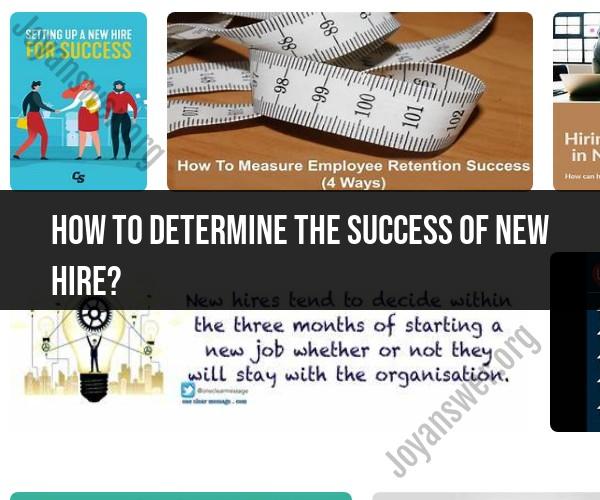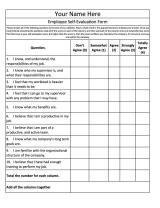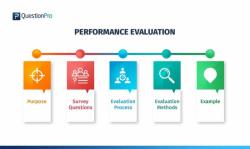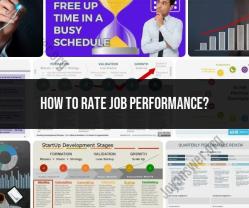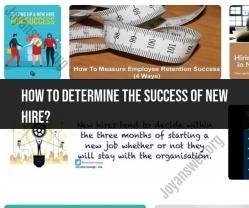How to determine the success of new hire?
Evaluating the success of new hires is crucial for both the employees and the organization. It helps in understanding the effectiveness of the hiring process, the onboarding program, and the individual's performance. Here are some assessment strategies to determine the success of new hires:
Set Clear Expectations:
- Establish clear job descriptions and performance expectations during the hiring process. This provides a baseline against which you can measure success.
Performance Metrics:
- Define key performance indicators (KPIs) or performance metrics for the role. These metrics should be specific, measurable, achievable, relevant, and time-bound (SMART). Regularly assess the new hire's performance against these metrics.
Managerial Feedback:
- Encourage regular feedback from the new hire's manager. Managers can provide insights into the employee's day-to-day performance, work attitude, and ability to meet expectations.
Peer and Team Feedback:
- Solicit feedback from colleagues and team members who work closely with the new hire. They can provide valuable insights into how well the new hire collaborates, communicates, and contributes to the team's success.
Self-Assessment:
- Allow new hires to self-assess their own performance and areas for improvement. This can promote self-awareness and personal accountability.
Probationary Periods:
- Implement a probationary period during which the new hire's performance is closely monitored. This can include weekly or monthly check-ins to track progress.
Performance Reviews:
- Conduct formal performance reviews at regular intervals (e.g., quarterly or annually) to discuss the new hire's achievements, strengths, weaknesses, and development goals.
Goal Achievement:
- Assess whether the new hire is meeting their individual goals and objectives. If not, work with them to understand the challenges and develop a plan for improvement.
Skills Assessment:
- Evaluate whether the new hire possesses the necessary skills and competencies for their role. Consider skills assessments, tests, or skill-based projects as part of the evaluation.
Cultural Fit:
- Assess how well the new hire integrates into the organization's culture. A good cultural fit can be just as important as job performance.
Engagement Surveys:
- Include new hires in regular employee engagement surveys to gauge their satisfaction, morale, and sense of belonging within the organization.
Retention Rate:
- Evaluate the retention rate of new hires. A high turnover rate among recent hires may indicate issues in the hiring or onboarding process.
Customer and Client Feedback:
- If applicable, collect feedback from customers or clients who interact with the new hire. Their experiences can reflect the new hire's performance in a customer-facing role.
Training and Development Progress:
- Monitor the new hire's participation and progress in training and development programs. This can indicate their commitment to personal and professional growth.
Time-to-Productivity:
- Assess how quickly the new hire becomes fully productive in their role. A shorter time-to-productivity can indicate a successful onboarding process.
Innovative Contributions:
- Recognize and reward new hires for their innovative contributions or suggestions that positively impact the organization.
Remember that the assessment strategies should align with the specific goals and expectations set for the new hire's role. Regular and constructive feedback, along with ongoing support and development opportunities, are essential for helping new hires succeed and contribute effectively to the organization.
How can you determine the success of a new hire?
There are a number of ways to determine the success of a new hire. Some of the most common methods include:
- Performance reviews: Performance reviews are a formal way to assess an employee's performance against their job expectations. They can be used to identify areas where the employee is excelling and areas where they need improvement.
- Customer feedback: Customer feedback can be used to assess how well the new hire is interacting with customers and meeting their needs.
- Team feedback: Team feedback can be used to assess how well the new hire is working with their colleagues and contributing to the team.
- Self-assessments: Self-assessments can be used to get the new hire's perspective on their own performance.
What key performance indicators (KPIs) are used to assess new hire success?
Some of the most common KPIs used to assess new hire success include:
- Time to productivity: This measures how long it takes the new hire to become fully productive in their role.
- Quality of work: This measures the quality of the new hire's work, such as the accuracy, completeness, and timeliness of their work.
- Customer satisfaction: This measures how satisfied customers are with the new hire's service.
- Team engagement: This measures how engaged the new hire is with their team and the company.
- Goal achievement: This measures how well the new hire is meeting their individual and team goals.
What is the role of employee onboarding in evaluating new hire success?
Employee onboarding is the process of integrating a new employee into a company and its culture. It is an important part of the new hire experience and can play a role in evaluating their success.
A well-designed onboarding program can help new hires to:
- Get up to speed on their job responsibilities and expectations
- Learn about the company culture and values
- Build relationships with their colleagues and manager
By providing new hires with the support and resources they need to succeed, onboarding can help to ensure that they are more likely to be successful in their roles.
Can you share best practices for measuring the effectiveness of a new hire?
Here are some best practices for measuring the effectiveness of a new hire:
- Use a variety of metrics: Don't rely on just one metric to measure new hire success. Use a variety of metrics, such as performance reviews, customer feedback, team feedback, and self-assessments, to get a complete picture of the new hire's performance.
- Compare new hires to peers: Compare the new hire's performance to their peers and to historical averages. This can help you to identify any areas where the new hire is struggling or where they are excelling.
- Track new hire progress over time: Don't just measure new hire success at one point in time. Track their progress over time to see how they are developing and improving.
- Get feedback from stakeholders: Get feedback on the new hire's performance from their manager, colleagues, and customers. This feedback can help you to identify any areas where the new hire needs improvement.
What are the common challenges in gauging the success of new employees?
Some of the common challenges in gauging the success of new employees include:
- Subjective measures: Some of the most common measures of new hire success, such as performance reviews and team feedback, are subjective. This means that they can be influenced by the personal biases of the people providing the feedback.
- Lack of data: It can be difficult to track new hire progress over time, especially if the company does not have a good system for collecting data on employee performance.
- Changing expectations: The expectations for new employees can change over time. This can make it difficult to gauge their success accurately.
Despite these challenges, it is important to measure new hire success. By tracking new hire progress and identifying areas where they need improvement, companies can help new hires to be more successful in their roles.
